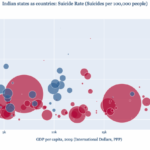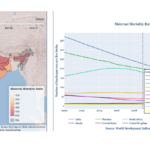Picture This: Infant Mortality Rate
Figure 1
Figure 2
Infant Mortality Rate (IMR) is defined as the number of infant deaths (age less than 1 year) per 1000 live births. In 2018, India had an infant mortality rate of 32, according to the Sample Registration System (SRS). Figure 1 above looks at the how infant mortality rates in India have changed between 2004 and 2018. The chart also plots the rates for the worst performing and best performing states in India (Madhya Pradesh and Nagaland respectively). The dotted line represents the average infant mortality rate for low- and middle-income countries according to the World Bank.
In 2004, India had an IMR of 58 while the average for low-and middle-income countries was 50. In the same year, MP had a IMR of 79 while Nagaland was at 17. In 2018, the IMR for India had come down to 32 while the average for low-and middle-income countries was 31. In the same year, MP saw an IMR of 48 while Nagaland had come down to 4.
In India’s immediate neighbourhood, Sri Lanka had an IMR of only 6.4 in 2018, while Bangladesh had an IMR of 26.7. This shows that India lags even the smaller economies in its neighbourhood.
Figure 2 above shows us the annual changes in a state’s IMR, as per SRS. The slider in the top right corner allows us to change the year and hovering over a state shows us the IMR for that state in that year.
When we look at year 2018, we find the regional variations in IMR which points to the differences in human development across the country. Goa, and Kerala have an IMR of 7 while MP has an IMR of 48.
Like HDI, IMR also provides us a measure of human development and can help guide policy to improve these outcomes.
If you wish to republish this article or use an extract or chart, please read CEDA’s republishing guidelines.







